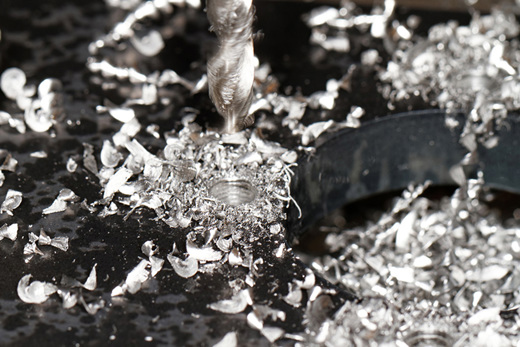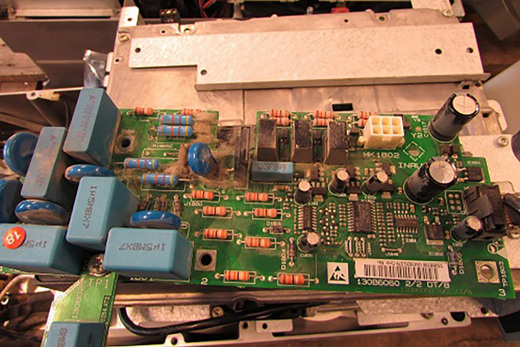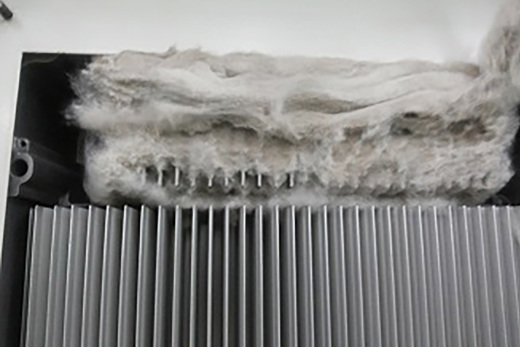
Did you know that your AC drives have allergies?
It’s true and many of the AC drives ever released share a similar allergy to you and I – dust. Of course, the amount of dust that affects our allergies doesn’t impact AC drives in the same ways. But, over time with enough dust, your AC drive will start to show symptoms. Additionally, fluff and filings can all impact the general health of your AC drives in many different ways. Today, we’ll look at these different ‘allergens’, discuss how to fight them, and take a look at some of the Danfoss Drives options that can minimize the impact of these environmental factors and ensure that your investments last as long as possible.

Dust is not as innocent as it looks
Since dust is the first item in this entry’s title, that’s where we’ll start. As you might recall from Drives vs. Enclosure classifications, many of the standard enclosure classifications of AC drives simply don’t protect against dust. In these AC drives, there are openings in the enclosure to let air flow over the components to keep them cool and running efficiently. Because these openings don’t often include screens or filters, this allows dust and other particulates to enter the drive while riding the airflow. Some of this dust then sticks to the components of the AC drive due, especially to the heat sink, reducing the efficiency of heat exchange with the air around it. Additionally, since many AC drives are actively cooled – meaning they use a fan to force air past the heat sink – this dust will also build up on the fan blades and in the bearings causing greater wear and tear.
The make-up of the dust in your particular facility is greatly affected by the process that you’re running and, as a result, can have different impacts on your AC drives and other electrical equipment. For example, very fine particulates, such as those that would be found at a gypsum processing facility, tend to cling to almost everything. If this facility were also in a region with regular amounts of high humidity, this can result in what most closely resembles a paste that can harden into a shell, preventing direct contact with the cooling medium and the surrounding air. Other facilities where the focus is metals processing can create a conductive dust that, as you can appreciate, could cause a lot of problems with improperly protected electronics.

Fluff and fibers can cause failures
Fluff is actually, in a sense, a bigger nuisance than some dusts. As you can probably imagine, fluff and fibers are present not only in textile operations but also in facilities where fiberglass insulation, for example, is made. Much like with dust, fluff is small enough to pass through the air flow channel of your AC drive if the air is unfiltered. Unlike dust, however, fluff is larger and can easily get caught on the heat sink, in the air filters (for drives placed in cabinets) or tied up in the fan. The fluff then collects other fibers that tangle up and can almost completely block the air-flow channel of your AC drive.
Additionally, if the fluff makes it to the fan, enough of it can reduce the fan’s cooling capability, prevent the fan from spinning, and cause premature fan failures. This can produce overheating and derating of the AC drive, and ultimately reduce its operational lifetime. Fluff accumulation inside the drive can also produce hot spots and reduce the creepage distance, resulting in a lower high voltage withstand level especially in high humidity conditions, causing failures. Therefore, making sure to protect your AC drives properly in these applications is extremely important.
Filings can cause anything from a spark to a full short circuit
Lastly we have filings, which you might be familiar with if you’ve ever done any woodworking or metal working. Filings are the little pieces of a material that fly off in the machining process. Most of the time, these aren’t a major concern, but when the filings are metallic, that’s when the trouble can arise. If you have electronic equipment such as AC drives installed near the machinery, these filings can land on unprotected areas of the equipment. In AC drives, these unprotected areas, especially for IP00/UL Open Type equipment, can be power terminals, motor terminals, DC bus terminals, external brake resistor terminals or something else. If these metallic filings land on any of these terminals, the result can be anything from a spark to a full short circuit that can result in the destruction of the AC drive and potentially other nearby equipment. Obviously, that’s something you would like to avoid.
Take the necessary precautions
Luckily, there are some fairly straightforward steps that you can take to ensure minimal exposure to dust, fluff and filings.
The first option is to ensure that your AC drives are installed in a clean room away from the dust. If that’s not so easy, however, installing your AC drives in a higher classified enclosure is the next best option. On these types of installations, since you still have to draw air into the enclosure to provide proper cooling, a filter on inlet of the cooling air will greatly help keep dust out of the enclosure. Make sure, though, that you’re using a filter that’s able to work on the typical particulate sizes in your facility, as certain filters may be unable to prevent fine particulates from entering the enclosure. Additionally, when adding a filter to your enclosure, keep in mind that this will reduce the flow rate of the air through the enclosure, so adjust for this when designing your cooling methods.
Beyond installation location, however, there are some options you can select on your AC drive to help. A great option is to make sure that your AC drive includes some conformal coating of the electronic components (coated printed circuit boards or encapsulated/potted components). In addition to protecting the circuitry from a certain degree of dust, including conductive dust, conformal coating provides a degree of protection against corrosive atmospheric conditions. To help to extend service life and ensure enhanced reliability, Danfoss Drives offers conformal coating in all product series within our portfolio.
A second option is to select an AC drive that is designed with a higher degree of enclosure protection. By selecting an AC drive such as the VLT® AutomationDrive or the VACON® 100 INDUSTRIAL, with an IP54/UL Type 12 enclosure classification rating, you’ll have a larger degree of protection against dust than an IP21/UL Type 1 enclosure. If you would like even more protection against dust, then selecting an AC drive such as the VACON® 20 X or VLT® Decentral Drive, both of which are rated for IP66/UL Type 4X enclosure classifications, would be your best option.
Another option to consider is the use of liquid-cooled or cold plate AC drives. The innovative cooling methods in drives, such as VACON® 20 Cold Plate and VACON® NXP Liquid Cooled avoid direct airflow over the electronics to reduce the risk of contamination from dust or other particles.
The importance of preventative maintenance
Most importantly, regardless of your AC drive selection and installation location, keeping a rigorous preventative maintenance routine will help ensure the longest life of your investment. If your AC drive is installed in an enclosure with a filter, regularly changing the filter will ensure that you will both prevent dust from entering the enclosure and maintain an appropriate air flow through the enclosure to help with cooling. If your AC drive isn’t mounted in a clean area, inspect the air flow channels at regular intervals to make sure that dust or fibers aren’t building up and reducing the cooling capability of your AC drives. If a visual inspection isn’t simple, keep track of the drive temperature parameters. Any significant increases in temperature under otherwise normal operating conditions can potentially indicate that there’s some build-up preventing appropriate cooling.
Following the fairly uncomplicated steps in this post will help to ensure that your investments continue to work for you for many years to come.
Check back regularly with us here at FocusOnDrives.com for regular updates on the best ways to ensure that your investments in AC drives are always the safest investments around. Next time, in Part 8 in the “It’s a harsh world…” series, we’ll look at Drives vs. Condensation, humidity and corrosion, where we discuss how moisture impacts your AC drive, whether corrosive or not. Additionally, let us know in the comments what environmental impacts give you the biggest challenges and how we can help you overcome them. Regardless of whose name is on the label, we’re here to help! In the meantime, you can find out more about all our products here.
Authors:
Jake Roeder, Global Product Marketing Manager, Danfoss Drives
Abraham González Ponce, Application Knowledge Manager, Application & Service Products, Danfoss Drives
